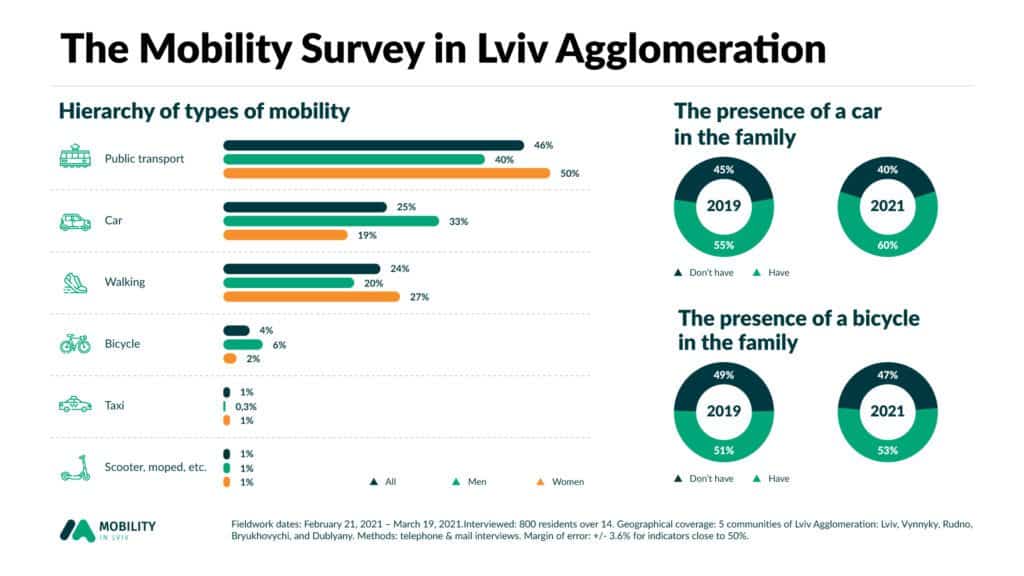By Tetiana Prykhodko (Sociologist, Head of Analysis & Research Program at City Institute)
COVID-19 changed people’s daily life. These changes have also influenced the mobility behavior of citizens: from daily routes to traveling outside their community. The Municipal Institution “City Institute” together with the working group of Lviv’s Sustainable Urban Mobility Plan (SUTP) conducted a mobility research (Sociological Survey and Modal Split) funded by the Deutsche Gesellschaft für Internationale Zusammenarbeit (GIZ) GmbH during the cold season of Lviv in 2021.
Methodology: The study focuses on three issues: (1) Residents’ main mobility routes, (2) Residents’ key mobility modes (car, public transport, bicycle, walking etc.), (3) Residents’ social profile and ownership of certain transport types.
The main feature of the study is the surveying of citizens not only from the city of Lviv but from communities that were amalgamated with Lviv in 2021, after the new administration units were created in Ukraine and Lviv territorial community established. This enables us to a better and more precisely understaning of the mobility of all citizens.
Fieldwork dates: February 21, 2021 – March 19, 2021
Survey respondents: 800 residents over the age of 14.
Geographical coverage: City of Lviv and 4 communities (Vynnyky, Rudno, Bryukhovychi, and Dublyany) amalgamated with Lviv within Lviv territorial community.
Methods: Interviews via Telephone and E-Mail.
Margin of error: +/- 3.6% for indicators close to 50%.
In the key findings section below we compare the data gathered during this study (cold season) and another one conducted in 2019 (warm season).
Key Findings
1. The share of people who did not move on weekdays is 26%, which is three times more than in 2019 (10%). This situation can be explained by the cold season ongoing during the survey and the fact that people who are a COVID-19 risk group limited their daily and social activities.
2. Residents prefer public transport as a mobility mode for traveling for different purposes with a share of half of the surveyed citizens (46%). The share is 7% lower than 2 years ago. We assume that this is due to the restrictions that occurred during the 2 waves of quarantine. This provides evidence of the conscious behavior of residents to reduce their social contacts and to avoid crowded places. On the other hand, walking has become an alternative to public transport: despite the fact that the survey was conducted in the cold season, the percentage of walking increased from 18% (2019) to 24% (2020). The important aspect related to walking as a mobility mode is that, according to the Lviv SUMP, it should be the most popular mobility mode. Therefore, sustainable mobility modes (walking, cycling) in Lviv should be prioritized financially and best practices that improve walking mobility should be implemented.

3. We consider the communities where we conducted our research as «20-minute communities». Analysis of mobility time intervals shows that 51% of residents often spend an average of 20 to 40 minutes to move around the city. Among these movements almost a third (27.1%) is a movement in the range “20-30 minutes”. Those who use a bicycle get to the destination the fastest (56% travel the distance in 20-30 minutes). It is a positive aspect, taking the cold season into consideration. Lviv cycling infrastructure is already at a high level of development, but both the logic of route networks and the safety level of some bicycle lanes need to be improved.

4. Since the Revolution of Dignity in 2014, the share of cars in families has increased from 48% to 60% (increase of 12%). Almost 38% of the respondents of the survey had their own car in 2021. Men are more likely to own a car (50%) than women (29%). Car owners mostly have cars with an internal combustion engine (95%). 2.7% answered about the presence of electric cars. According to the official statistics, Lviv car drivers have become more careful driving and the number of traffic accidents with victims decreased from 820 cases in 2019 to 645 cases in 2020.
5. The attempts of bicycle users to influence decision-making in the city prove the existence of an active cycling community. The proportion of those who report having a bicycle in their family (excluding children under 14) is approximately 53%. Lviv bicycle users highlightes during focus groups that the city has become more friendly to them, allowing the family bicycle activities among multi-aged residents.
So, mobility studies, in particular, studies about citizens mobility behavior and systemic mobility monitoring are key enablers for data driven decision making, predicting and modeling mobility trends and developing sustainable mobility, in general. We believe that in cities like Lviv, mobility is a challenge and local self-governments should have the transport and mobility behavior on the top of their priority list of policies and actions. Data gathered during both Mobility Research Lviv (cold season) done in 2021 and Mobility Research Lviv (warm season) provided in 2019 is a good basis for a successful planning and implementation of SUMP Lviv until 2030 and even to scale up good mobility practices started up during the COVID-19 pandemic.
For more information see the presentation of The Mobility Survey and the SUMP Lviv and/or write an email to Tetyana Pryhodko: t.pryhodko@city-institute.org.
The research was implemented within the framework of the Lviv Sustainable Urban Mobility Plan. Involved organizations: «Integrated Urban Development in Ukraine II», implemented by the German government company «Deutsche Gesellschaft für Internationale Zusammenarbeit (GIZ) GmbH» with funding from the Governments of Germany and Switzerland in cooperation with the Lviv City Council, municipal institution City Institute, Lvivavtodor, Lvivelectrotrans, Institute of Spatial Development, Department of Housing and Infrastructure, Department of Transport, Office of Architecture and Urban Planning of the Department of Urban Development, public organizations.
